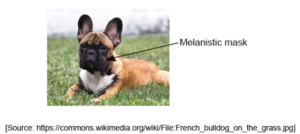5. Some breeds of dogs are characterized by the presence of a melanistic mask, which is a darkening of the fur near the nose, as shown by the arrow in this photograph.

Which outcome is matched with a valid conclusion if dogs that were pure breeding for melanistic masks were crossed with dogs without melanistic masks?